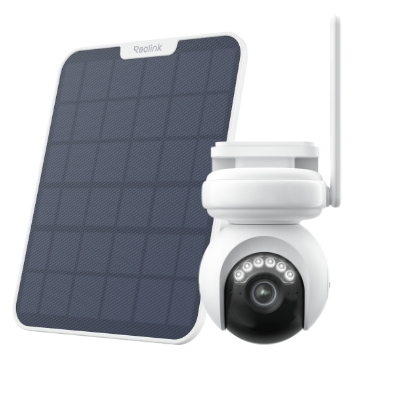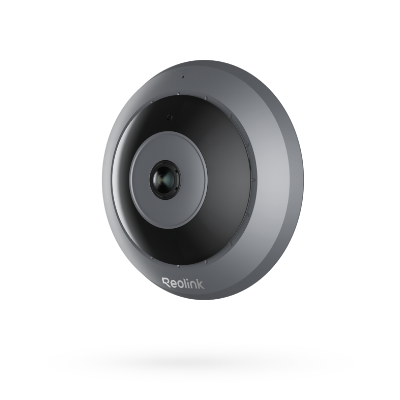Best 360-Degree Security Camera: Ensuring Comprehensive Surveillance
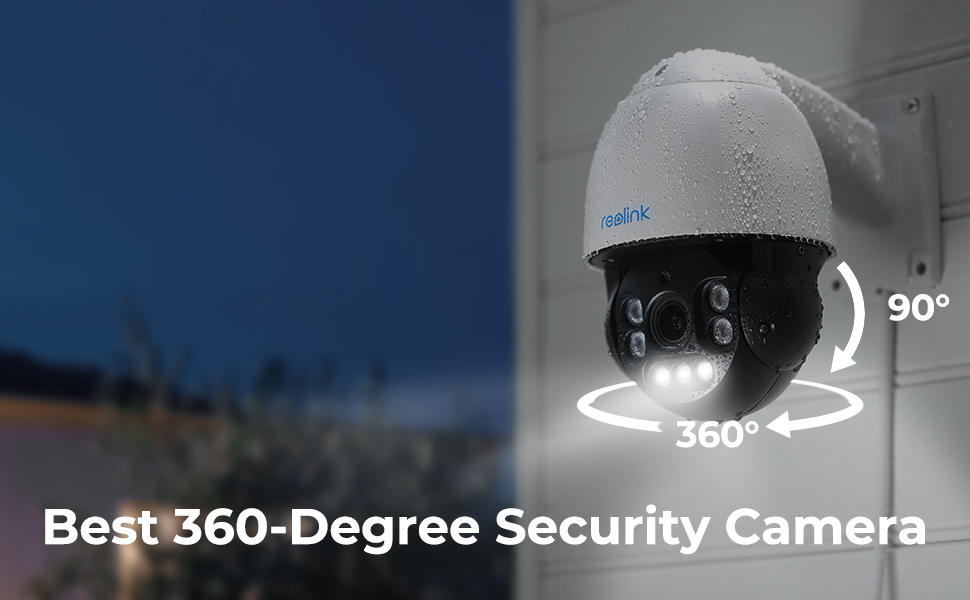
Due to technological advancements, reliable security systems are becoming increasingly important. Both residential and commercial spaces require a comprehensive surveillance solution to ensure their safety and security in today's fast-paced world. One such innovative solution that has gained immense popularity is the 360-degree security camera.
These cameras can monitor a comprehensive view of your surroundings, minimizing blind spots and providing unparalleled security solutions. In this article, you will learn about different types, benefits, and features of 360-degree security cameras.
Reolink Christmas Sale – Security Cameras Up to 43% Off Now!
Reolink Christmas Sale is coming! Get up to 43% off on top products like the Altas PT Ultra+SP, Argus 4 Pro+SP, Argus PT Ultra+SP, Battery Doorbell, TrackMix WiFi, and more! Shop now to secure your home for less!
- What is a 360-Degree Security Camera?
- Common Types of 360-Degree Security Cameras
- Unparalleled Advantages of 360-Degree Security Camera
- Best Picks for 360-Degree Security Camera
- How to Choose Outdoor 360-Degree Security Camera
- Wired vs. Wireless 360-Degree Security Camera: Key Considerations
- 360-Degree Security Camera Installation Tips
- FAQs
- Conclusion
What is a 360-Degree Security Camera?
A 360-degree security camera, also known as an omnidirectional camera, is a type of surveillance camera that captures a full 360-degree view of its surroundings. Unlike traditional fixed-angle cameras with a limited field of view, a 360-degree camera offers a comprehensive panoramic view, allowing for monitoring a wide area without blind spots.
These cameras use specialized lenses and image sensors to capture an all-encompassing view in a single frame. They can cover the entire horizontal and vertical range, providing a complete picture of the monitored space. Some 360-degree cameras also offer the ability to digitally pan, tilt, and zoom within the captured panoramic image for detailed examination of specific areas.
Common Types of 360-Degree Security Cameras
There are several types of 360-degree security cameras available in the market. Here are some common ones.
Fisheye Cameras
This type of 360-degree security camera uses a specialized fisheye lens to capture an ultra-wide-angle view, typically covering an entire 180-degree or 360-degree field. The captured image or video appears distorted, resembling a fisheye lens effect, hence the name.
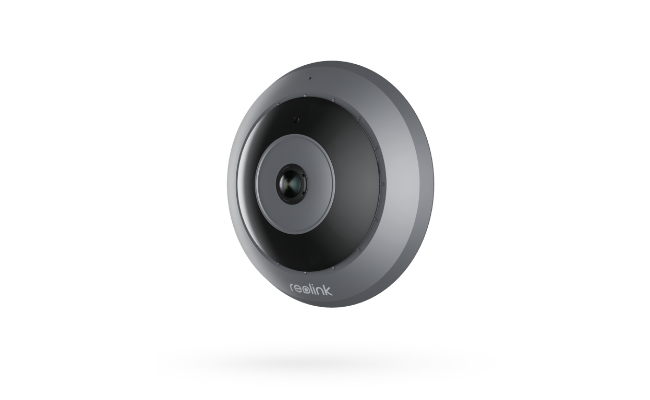
Fisheye cameras can also provide a panoramic view of their surroundings. However, it's important to note that not all fisheye cameras offer accurate 360-degree coverage. Some fisheye cameras capture a 180-degree hemispherical view, while others use multiple fisheye lenses to stitch together a complete 360-degree image.
Watch the video below to experience the panoramic view offered by the Reolink fisheye security camera.
Panoramic Cameras
Panoramic cameras utilize multiple image sensors or lenses to capture a 360-degree view. They stitch together the images to create a seamless panoramic image or video. Panoramic cameras can be fixed or adjustable, allowing for different angles and zoom levels.
PTZ Cameras with Panoramic Capability
Some PTZ (Pan-Tilt-Zoom) cameras come with built-in panoramic capabilities. These cameras combine the ability to pan, tilt, and zoom with a wide-angle lens or multiple sensors, providing both the flexibility of PTZ control and the panoramic view.
Note: For a more in-depth understanding of PTZ cameras, we recommend referring to our comprehensive guide on 4K PTZ security cameras.
Multi-Sensor Cameras
Multi-sensor cameras feature multiple image sensors or lenses arranged in a single unit. Each sensor captures a portion of the scene, and the images are stitched together to create a complete 360-degree view. Multi-sensor cameras offer high-resolution panoramic images and can be adjusted for various viewing angles.
Immersive Cameras
Immersive cameras, also known as virtual reality (VR), capture a full 360-degree view in horizontal and vertical dimensions. They are primarily used for immersive video experiences or virtual reality applications, allowing viewers to feel fully immersed in the recorded environment.
Why Choose the 360-Degree Security Camera?
Traditional fixed-angle cameras may leave blind spots, compromising the surveillance system's effectiveness. This unparalleled advantage is where the 360-degree security camera is a game-changer. With its ability to capture a complete panoramic view, the 360-degree security camera offers exceptional coverage, eliminating blind spots and enhancing situational awareness. Here are some of the reasons why users chose the 360-degree security camera.
Expanded Coverage and Reduced Blind Spots
One of the primary advantages of a 360-degree security camera is its ability to provide expanded coverage and eliminate blind spots. Traditional cameras often have limitations in their field of view, leaving certain areas vulnerable to unauthorized access or criminal activities. With a 360-degree camera, you can monitor an entire room or outdoor space, ensuring comprehensive surveillance without any blind spots.
In addition to the panoramic view, these cameras can often pan, tilt, and zoom, giving you complete control over the surveillance. With remote access through a mobile app or web interface, you can adjust the camera's position and zoom in on specific areas for a closer look.
Simplified Installation and Cost-Effective Solution
Investing multiple cameras to cover a large area can take time and effort. With a 360-degree security camera, you can achieve the same level of coverage with a single device, reducing installation complexity and cost. Moreover, the centralized monitoring and management of a single camera streamline your surveillance system, saving you time and effort in the long run.
Enhanced Situational Awareness
360-degree security cameras provide invaluable situational awareness by capturing a complete view of your surroundings. Whether you're monitoring your home, office, or public space, having a panoramic perspective enables you to quickly identify potential threats, suspicious activities, or emergencies. This enhanced awareness allows for timely responses and proactive measures to ensure the safety of your property and the people within it.
High-Quality Imaging and Advanced Features
The best 360-degree security cameras offer high-resolution imaging capabilities, ensuring clear and detailed footage. With technological advancements, these cameras now include color night vision, motion detection, two-way communication, smart home compatibility, and even person or pet recognition. These additional functionalities enhance the camera's overall security and monitoring capabilities, providing you with peace of mind.
Best Picks for 360-Degree Security Camera
360-degree cameras offer a complete view of your surroundings, leaving no blind spots. Now is the perfect time to explore the following product recommendations and embark on the journey toward fortified security.
Best Battery-Powered Security Cameras with 360-Degree View - Reolink Altas PT Ultra
If you're looking for a battery-powered security camera with a 360-degree view, check out the new Reolink Altas PT Ultra. It has advanced pan and tilt features, covering a wide area and tracking objects automatically.
Industry-leading 4K Continuous Recording Battery Camera
4K UHD Continuous Recording; ColorX Night Vision; Pan & Tilt; Automatic Tracking; All Recordings Stored Locally.
The camera's standout feature is its battery. The 20,000 mAh battery allows for over 8 days of continuous recording, based on 12 hours of use per day. It also has a large lens aperture and advanced image sensor, offering true full-color night vision even in low light.
Best 360-Degree Fisheye Security Camera: Reolink FE-W
Fisheye security cameras provide a revolutionary and efficient solution for home and business surveillance needs. Reolink FE-W, a WiFi-enabled fisheye security camera, can revolutionize your surveillance experience. With its 360° panoramic view, this camera ensures complete coverage of every corner of your room. The 6MP super HD resolution guarantees crystal-clear images and videos, enabling you to examine even the finest details.
6MP WiFi 360° Panoramic Indoor Fisheye Camera
6MP Super HD, 360° Panoramic View, 5/2.4 GHz Dual-Band WiFi, Multiple Display Modes, Smart Person Detection, Two-Way Audio, Clear Night Vision.
Reolink fisheye cameras are a powerful deterrent due to their smart motion detection and real-time alert functionality. Working seamlessly over 2.4/5 GHz WiFi frequencies, this wireless surveillance device provides the same coverage as four traditional security cameras, making it an ideal choice for monitoring your store, office, meeting room, warehouse, and more.
Best 360-Degree PTZ Security Camera: Reolink RLC-823A
PTZ cameras distinguish themselves from other 360-degree security cameras due to their exceptional features. Reolink RLC-823A, a cutting-edge 360-degree PTZ security camera, ensures comprehensive coverage and peace of mind. Equipped with a high-resolution lens and 5X optical zoom, RLC-823A delivers crystal-clear images and allows you to zoom in for detailed observation. The 360-degree pan and 90-degree tilt capabilities enable flexible monitoring of your surroundings, leaving no blind spots.
Smart PTZ PoE Camera with Spotlights
4K 8MP Ultra HD, Person/Vehicle Detection, 5X Optical Zoom, Auto Tracking, Manual Pan & Tilt, Two-Way Audio, 190ft Night Vision, Live View.
Featuring advanced motion detection, the RLC-823A keeps you alerted to any suspicious activity in real time. Whether it's day or night, the camera's exceptional night vision ensures clear and detailed footage, even in low-light conditions. Furthermore, the RLC-823A can withstand various outdoor elements, making it suitable for residential and commercial use.
Choosing Outdoor 360-Degree Security Camera: Factors to Consider
Due to their more comprehensive coverage, 360-degree security cameras apply perfectly to the outside. When selecting an outdoor 360-degree security camera, one must consider specific features contributing to their performance and suitability for outdoor environments. Here are some key features to look for.
Weatherproof Design
Ensure that the camera you choose has a durable and weatherproof construction. It should withstand various weather conditions, including rain, snow, humidity, and extreme temperatures. Look for cameras with an IP (Ingress Protection) rating indicating their protection level against water and dust. The optimal IP rating for outdoor security cameras is IP65 or higher.
Note: To gain a deeper understanding of the IP rating of security cameras, we recommend referring to our comprehensive guide on 4K outdoor security cameras. Within the guide, a dedicated section on Weatherproof Capability provides valuable insights into this crucial parameter.
High-Resolution Imaging
Opt for a camera with high-resolution imaging capabilities. Higher resolution ensures the captured footage is clear and detailed, quickly identifying individuals, objects, or events. Look for cameras with at least Full HD (1080p) or higher resolution for optimal image quality. Currently, numerous manufacturers are introducing 4K or higher-resolution products. You can explore these offerings to determine if they provide 360-degree coverage.
Reliable Night Vision Capability
Outdoor surveillance requires reliable night vision capabilities. Look for cameras with built-in infrared (IR) LEDs or other advanced night vision technologies that can capture clear footage even in complete darkness. For instance, cameras are available with built-in spotlights that support color night vision, as well as those equipped with large sensors that excel in low-light environments. Consider the range and clarity of the night vision to ensure effective monitoring during nighttime hours.
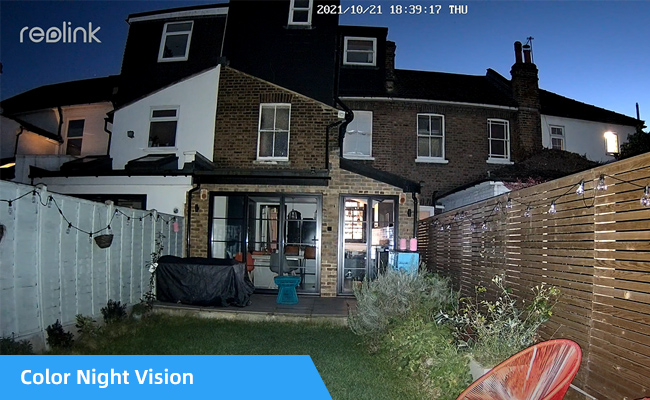
Wide Dynamic Range (WDR)
WDR, which stands for Wide Dynamic Range, is a technology employed in cameras, including security cameras, to address complex lighting scenarios. It aids in harmonizing an image's brightness and contrast levels, mainly when dealing with high-contrast situations featuring dark and bright areas.
Outdoor environments frequently exhibit diverse lighting conditions, ranging from intense sunlight to deep shadows. Cameras equipped with Wide Dynamic Range (WDR) technology excel in challenging lighting conditions by ensuring optimal exposure for dark and bright regions in the captured footage. This results in well-balanced and crisp images, enhancing overall visibility and clarity.
Power Source and Connectivity
When utilizing a 360-degree camera outdoors, it is vital to consider the power source and connectivity options available. The limited length of power outlets and Internet connection cables can significantly impact the device's proper functioning, making this aspect crucial to address.
Some outdoor 360-degree security cameras are battery-powered, providing flexibility in installation and placement. Others may require a direct power source or PoE (Power over Ethernet) connectivity. Choose the option that suits your requirements and offers a reliable power supply.
Motion Detection
Motion detection is a critical feature in outdoor cameras that allows them to sense and respond to movement within their field of view. When enabled, the camera monitors its surroundings for any changes or motion. Upon detecting motion, the camera can trigger various actions, such as sending notifications, recording video footage, or activating alarms.
For enhanced monitoring effectiveness, consider selecting a device with motion detection and other intelligent features. These features improve the camera's ability to detect potential threats and increase the overall effectiveness of the security system.
Wired vs. Wireless 360-Degree Security Camera: Key Considerations
360-degree security cameras may encounter connectivity issues impacting their performance and effectiveness like any technological device. Wireless and wired options are prevalent among the available 360-degree security cameras. Here are some essential factors to consider when selecting between them.
Key Considerations for Wireless 360-Degree Security Camera
Wireless cameras offer flexibility in placement and ease of installation, as the availability of physical wiring connections does not limit them. When considering a wireless 360-degree security camera, it's essential to consider the following factors.
- WiFi signal strength and range: Ensure your WiFi signal strength is sufficient to support reliable communication between the camera and the network. Consider the distance between the camera and the WiFi router and any potential obstructions or interference that may affect the signal range.
- Power source and battery life: Wireless cameras require a power source. Consider whether the camera is battery-powered or needs to be connected to a power outlet. Evaluate the camera's battery life or power consumption to ensure uninterrupted surveillance.
- Encryption and security: With wireless transmission, it's crucial to prioritize the safety of your camera system. Choose cameras that support encryption protocols, such as WPA2 or WPA3, to protect the integrity and confidentiality of the transmitted data. Additionally, regularly update the camera's firmware to address security vulnerabilities.
- Interference and bandwidth: Wireless cameras operate on specific WiFi channels, and interference from other devices or networks can impact their performance. Ensure that the camera works on a clear channel with minimal interference. Consider adjusting your WiFi settings or utilizing dual-band routers to mitigate interference issues.
- Video quality and compression: Evaluate the camera's video quality and compression capabilities. Higher-resolution cameras provide more apparent and detailed images, allowing for better identification of objects or individuals. Consider the camera's video compression format to balance storage requirements and video quality.
Key Considerations for Wired 360-Degree Security Camera
Wired 360-degree security cameras offer several advantages, such as stable power and data transmission, consistent performance, and minimal interference. When contemplating a wired 360-degree security camera, it is essential to consider the following factors.
- Cable routing and installation: Installing wired cameras requires careful planning for cable routing. Consider the layout of the area to be monitored and the path for running cables, taking into account any obstacles or structural considerations. Proper cable management ensures a neat and organized installation.
- Power supply requirements: Wired cameras require a nearby power source. Ensure that suitable power outlets are available near the camera locations or plan to install power extension cables or power over Ethernet (PoE) switches to provide power.
- NVR or central monitoring system: Wired cameras are typically connected to a network video recorder (NVR) or a central monitoring system. Ensure compatibility between the camera and the recording/monitoring equipment, including support for wired connections and the required network protocols.
- Professional installation: Due to the complexity of cable routing and connection setup, hiring a professional installation team for wired 360-degree security cameras is highly recommended. Professional installers have the expertise and tools to ensure proper installation, cable management, and camera positioning.
- Scalability and expandability: Consider the scalability and expandability of the wired camera system. Ensure that the NVR or central monitoring system supports the desired number of cameras and allows for easy integration of additional cameras in the future.
Bonus Tips: How to Install 360-Degree Security Camera to Maximize its Functionality
While 360-degree security cameras offer extensive coverage without any blind spots, it is crucial to install them to optimize their functionality strategically. To ensure the best results, consider the following installation tips.
Choose an Optimal Location
Select a position that offers a wide field of view and covers the desired surveillance area without obstructions. Consider factors like height, angle, and distance to ensure comprehensive coverage.
Mount the Camera Securely
Use appropriate mounting hardware to ensure a stable and secure installation. For example, you can utilize the included mounting template to mark the installation location for your Reolink camera accurately. Ensure the camera is firmly fixed and resistant to vibrations or external forces.
Consider Lighting Conditions
Evaluate the lighting conditions in the surveillance area. Supplement the ambient lighting with additional light sources to ensure optimal visibility and image quality.
Establish Power and Network Connections
Connect the camera to a reliable power source and establish a stable network connection. Use suitable cables and connectors, following the manufacturer's instructions.
Adjust Camera Settings
Configure the camera settings according to your specific requirements. Some requirements may include adjusting resolution, frame rate, motion detection sensitivity, and other parameters. Consult the camera's user manual or software interface for guidance.
Test and Fine-Tune
Once installed, test the camera's functionality by reviewing the live feed and checking the coverage. Make necessary adjustments to achieve the desired viewing angle and image quality.
FAQs
Are 360-degree security cameras suitable for outdoor use?
The answer is yes. Due to the ability to monitor broad areas, many 360-degree security cameras can withstand distinct outdoor environments with weatherproof and vandal-resistant features. When selecting a camera, be sure to check its IP rating. An IP rating of IP65 or higher for outdoor security cameras is ideal.
Can I view the footage from a 360-degree security camera remotely?
Yes, most 360-degree security cameras offer remote viewing capabilities. You can access live or recorded footage from anywhere with an internet connection through a mobile app or web browser.
Do 360-degree security cameras require professional installation?
While professional installation is recommended for optimal performance and positioning, many 360-degree security cameras are designed for easy installation and can be set up by individuals with basic DIY skills. Always refer to the manufacturer's instructions for guidance.
Which type of 360-degree security camera is better: wireless or wired?
It's hard to say which is better since choosing a wireless or wired 360-degree security camera depends on various factors and individual preferences. Wireless 360-degree security cameras offer flexibility in terms of installation as they don't require extensive wiring. They can be placed in locations that are challenging to reach with wired cameras.
On the other hand, wired 360-degree security cameras provide a reliable and consistent connection as they are directly connected to power and network sources. They can be more suitable for long-term installations or areas with a stable wired connection.
Conclusion
Investing in 360-degree security cameras is a smart choice for enhancing your surveillance system. With expanded coverage, reduced blind spots, and advanced features, these cameras offer unparalleled monitoring capabilities. 360-degree cameras are especially well-suited for outdoor applications. When selecting a camera, it is essential to consider factors like weatherproof construction, image resolution, night vision capabilities, and more.
If you are still undecided between wired or wireless 360-degree security cameras, the optimal choice relies on various factors such as specific surveillance needs, infrastructure at the location, and personal preferences. Are you familiar with the unique features of 360-degree security cameras? Do they offer additional capabilities? Share this article with your friends and join the conversation by commenting below.
Search
Be in the Know
Security insights & offers right into your inbox


